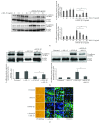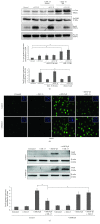Inhibition of TGF- β 1 Signaling by IL-15: A Novel Role for IL-15 in the Control of Renal Epithelial-Mesenchymal Transition: IL-15 Counteracts TGF- β 1-Induced EMT in Renal Fibrosis
- PMID: 31360169
- PMCID: PMC6642769
- DOI: 10.1155/2019/9151394
Inhibition of TGF- β 1 Signaling by IL-15: A Novel Role for IL-15 in the Control of Renal Epithelial-Mesenchymal Transition: IL-15 Counteracts TGF- β 1-Induced EMT in Renal Fibrosis
Abstract
Renal tubulointerstitial fibrosis is the final common pathway in end-stage renal disease and is characterized by aberrant accumulation of extracellular matrix (ECM) components secreted by myofibroblasts. Tubular type 2 EMT, induced by TGF-β, plays an important role in renal fibrosis, by participating directly or indirectly in myofibroblasts generation. TGF-β1-induced apoptosis and fibrosis in experimental chronic murine kidney diseases are concomitantly associated with an intrarenal decreased expression of the IL-15 survival factor. Since IL-15 counteracts TGF-β1 effects in different cell models, we analyzed whether (1) human chronic inflammatory nephropathies evolving towards fibrosis could be also characterized by a weak intrarenal IL-15 expression and (2) IL-15 could inhibit epithelial-mesenchymal transition (EMT) and excess matrix deposition in human renal proximal tubular epithelial cells (RPTEC). Our data show that different human chronic kidney diseases are characterized by a strong decreased expression of intrarenal IL-15, which is particularly relevant in diabetic nephropathy, in which type 2 tubular EMT plays an important role in fibrosis. Moreover, primary epithelial tubular cultures deprived of growth supplements rapidly produce active TGF-β1 inducing a "spontaneous" EMT process characterized by the loss of membrane-bound IL-15 (mbIL-15) expression. Both "spontaneous" EMT and recombinant human (rh) TGF-β1-induced EMT models can be inhibited by treating RPTEC and HK2 cells with rhIL-15. Through a long-lasting phospho-c-jun activation, IL-15 inhibits rhTGF-β1-induced Snail1 expression, the master inducer of EMT, and blocks TGF-β1-induced tubular EMT and downstream collagen synthesis. In conclusion, our data suggest that intrarenal IL-15 could be a natural inhibitor of TGF-β in human kidney able to guarantee epithelial homeostasis and to prevent EMT process. Thus, both in vivo and in vitro an unbalance in intrarenal IL-15 and TGF-β1 levels could render RPTEC cells more prone to undergo EMT process. Exogenous IL-15 treatment could be beneficial in some human nephropathies such as diabetic nephropathy.
Figures







Similar articles
-
MiR-30c protects diabetic nephropathy by suppressing epithelial-to-mesenchymal transition in db/db mice.Aging Cell. 2017 Apr;16(2):387-400. doi: 10.1111/acel.12563. Epub 2017 Jan 27. Aging Cell. 2017. PMID: 28127848 Free PMC article.
-
FSP1-specific SMAD2 knockout in renal tubular, endothelial, and interstitial cells reduces fibrosis and epithelial-to-mesenchymal transition in murine STZ-induced diabetic nephropathy.Cell Tissue Res. 2018 Apr;372(1):115-133. doi: 10.1007/s00441-017-2754-1. Epub 2017 Dec 6. Cell Tissue Res. 2018. PMID: 29209813
-
The glucagon-like peptide-1 (GLP-1) analog liraglutide attenuates renal fibrosis.Pharmacol Res. 2018 May;131:102-111. doi: 10.1016/j.phrs.2018.03.004. Epub 2018 Mar 9. Pharmacol Res. 2018. PMID: 29530599
-
Autophagy as a Therapeutic Target for Chronic Kidney Disease and the Roles of TGF-β1 in Autophagy and Kidney Fibrosis.Cells. 2023 Jan 26;12(3):412. doi: 10.3390/cells12030412. Cells. 2023. PMID: 36766754 Free PMC article. Review.
-
Matrix metalloproteinases contribute to kidney fibrosis in chronic kidney diseases.World J Nephrol. 2013 Aug 6;2(3):84-9. doi: 10.5527/wjn.v2.i3.84. World J Nephrol. 2013. PMID: 24255890 Free PMC article. Review.
Cited by
-
Monocytic Myeloid-Derived Suppressor Cells Inhibit Myofibroblastic Differentiation in Mesenchymal Stem Cells Through IL-15 Secretion.Front Cell Dev Biol. 2022 Feb 17;10:817402. doi: 10.3389/fcell.2022.817402. eCollection 2022. Front Cell Dev Biol. 2022. PMID: 35252184 Free PMC article.
-
IL-15 Prevents Renal Fibrosis by Inhibiting Collagen Synthesis: A New Pathway in Chronic Kidney Disease?Int J Mol Sci. 2021 Oct 28;22(21):11698. doi: 10.3390/ijms222111698. Int J Mol Sci. 2021. PMID: 34769128 Free PMC article.
-
Interleukin-15 in kidney disease and therapeutics.Curr Opin Nephrol Hypertens. 2024 Mar 1;33(2):174-180. doi: 10.1097/MNH.0000000000000964. Epub 2023 Dec 26. Curr Opin Nephrol Hypertens. 2024. PMID: 38164877 Free PMC article. Review.
-
New metallophamaceutic reduced renal injury induced by non-steroidal anti-inflammatory.Acta Cir Bras. 2020 Feb 3;34(12):e201901201. doi: 10.1590/s0102-865020190120000001. eCollection 2020. Acta Cir Bras. 2020. PMID: 32022101 Free PMC article.
-
Stem Cell-Derived Extracellular Vesicles as Potential Therapeutic Approach for Acute Kidney Injury.Front Immunol. 2022 Mar 10;13:849891. doi: 10.3389/fimmu.2022.849891. eCollection 2022. Front Immunol. 2022. PMID: 35359949 Free PMC article. Review.
References
LinkOut - more resources
Full Text Sources
Research Materials
Miscellaneous

